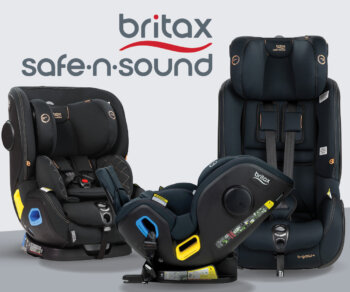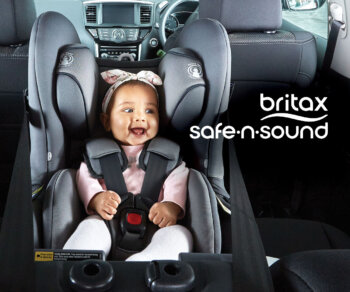Media kindly brought to you by Britax
Mastering the use of strollers to be more mobile with your infant or toddler is an important milestone that opens up many possibilities in your journey through life. Perhaps you’ve already chosen your ideal stroller but are nervous about putting it to the test with your child, or are still sussing out your options and keen for some advice to avoid mishaps during your outings together. Truth be told, from the moment they learn to sit up on their own unassisted, to the boisterous toddler years, hitting the pavement with your child and navigating in and out of cars is not always smooth sailing. That being said, parents and caregivers can prepare themselves by accessing the right information now, to ensure safer, happier outcomes.
Thankfully, our friends at Britax are here to help, drawing on their 50+ years experience helping families transport their little ones safely to their next destination. With an extensive range of innovative, industry-leading car seats, capsules and carriers, travel systems and strollers, they have first-hand knowledge of the typical situations parents and caregivers can encounter with a stroller, and useful tips to prioritise safety and provide peace of mind.
Double-check your child is restrained
The most obvious but crucial step, learning to restrain your infant or toddler properly is stroller safety 101. It’s important for you and other family members who will be operating the stroller to get it correct from the start, so you don’t adopt bad habits. To comply with Australian law, strollers must have a 5-point harness (2 shoulder straps, 2 waist straps and a crotch strap) to secure the child. Although it might seem excessive – particularly for infants – you’d be surprised at how much your child could move around and potentially slip out of the seat altogether if this safety system wasn’t in place. Straps should be tightened so there is no slack and they sit flat without any twists as if the worst was to occur and they took a tumble, loose and twisted straps will heighten the risk of injury.
Once you get the hang of this to the point it is second nature, vigilance is key. Parents get exceptionally busy and are exposed to numerous distractions, particularly with other children in tow, so try to take a moment to double-check before you set off. And don’t forget to provide refresher training to any caregivers that are infrequent users of the stroller.
Your brake and tether strap are your best friends
Just like attaching the 5-point harness, using the brake on your stroller will need to become an automatic process whenever you are stationary and especially in proximity to roads, traffic and other potential hazards. A runaway pram or stroller might be good fodder for a Hollywood movie, but is obviously a terrifyingly real scenario for parents and caregivers. Although the function is the same, brake mechanisms on prams and strollers and their associated ease of use differ among manufacturers. Seeing as you will be using it repeatedly throughout the day, choose one that is intuitive to lock into place and release. The Strider Signature V5 is one such pram that has a linked parking brake with red/green indicator locks that can be locked with a single step, making safety simple.
Of course, carers are not immune from accidents, and in the event that your pram or stroller does get away from you, a back up mechanism is crucial; your tether strap. A reinforced strap that connects your wrist to the handle of the pram or stroller, the tether is not an optional accessory, but rather, an intrinsic design feature in modern prams. It’s something grandparents in particular may not be used to, as you’ll find it’s missing from older generations of prams. Following a history of tragic incidents where children were killed or injured when their strollers rolled away from their caregivers, the decision was made in 2008 to mandate use of a tether strap on prams and strollers, as part of the Australian and New Zealand safety standards.
You can never be certain that a brake will be applied every single time that it’s required, with one such scenario being that you’ve had to urgently reach for another child to keep them out of harm’s way and not had time to apply the brake. With a brake and tether strap working in tandem, however, you’ll have that all-important failsafe and peace of mind. Just remember to pop it around your wrist at the earliest opportunity.
Don’t overload your stroller
A quality pram or stroller is designed to be robust and balanced in their construction to compensate for a wriggly infant or toddler, but that doesn’t mean you can test its limits unnecessarily. Avoid the temptation to hang shopping bags or parcels from the handles of the stroller – even momentarily – as their weight could make the pram or stroller unstable and cause it to tip over. Did you know that strollers tipping over due to placement of heavy bags is one of the most common injuries from prams or strollers in Australia? It only takes a split second and an averted gaze for a dangerous spill to occur. Instead, store bags and other items in the basket underneath the pram or stroller to stabilise their weight evenly in the pram. And to address another source of overloading – this time courtesy of your little one as they grow and become more assertive, try to educate them not to stand up or lean out of their stroller.
Consider who is operating the stroller
User error obviously plays a big role in pram and stroller-related accidents, and it’s compounded by the type of stroller relative to the person. Heavy-duty travel systems or strollers with all the bells and whistles are user-friendly for most able-bodied adults, but may pose a problem for older adults and the elderly who are not capable of using them for too long or over steep inclines. Britax recommends that if a grandparent is to be a regular caregiver, you may want to invest in an umbrella stroller. An alternative to a full-sized pram, umbrella strollers are a stripped-back or simplified version of a traditional stroller that is lightweight and easier to manoeuvre and fold down for storage. Check out the Steelcraft range of strollers which have adjustable backrests and swivelling front wheels, meaning they’re very manoeuvrable to push and won’t cut short your journey.
Observing car parking safety and etiquette
Keeping a watchful eye on two or three young children is obviously more challenging than just one, and if you’ve got one walking child and one in the pram or stroller, it can present a bit of a dilemma when it comes time to getting everyone back in the car at the end of your on-foot journey. Especially if you’re in a crowded car park; a task that some parents would liken to a military-style operation! Unless you’re with your partner or other caregiver, you can’t secure the children simultaneously, so who do you secure in the car first, and how do you keep the other(s) safe while you attend to the first? Do a Google search to this effect, and you’ll find a host of questions on online forums with mums seeking advice and being quite bemused that a shopping trip has gotten so complicated.
Operating on the logic that the more mobile a child is, the greater the risk of them leaping out into trouble, Britax recommends the following: “if you’ve got one walking and one in the pram, put the walking child in the car first then transfer the younger child from the pram into their car seat. The kids are safest when strapped in their seats, giving you the freedom to properly unpack the shopping and load up the car properly.” Another final word of warning is to not park the stroller right at the rear of the car and adjacent to the path of cars if you can avoid it, as even if your brake and tether strap prevent rolling, they will not safeguard against being clipped by another vehicle that has approached too close.
Watch for sleep and don’t leave your child unattended
It’s important to remember that prams and strollers are not designed for unsupervised sleep or restraint. If your child decides to have a snooze while you’re out and about or even at a friend or family member’s house, let sleeping dogs lie as the saying goes, but don’t leave them unattended. Same goes for leaving them awake and unattended, as without the rhythmic movement of their stroller being pushed, infants or toddlers can get pretty restless, fast. And even their slumber could result in movement that is capable of tipping over the stroller. Aside from a flood of tears, bruising and scrapes, such a tumble could even lead to strangulation or suffocation risks, according to expert advice.
There’s no doubt that use of a stroller involves a learning curve for new parents or caregivers, and can even ruffle the feathers of the most seasoned parent. But armed with the above advice that addresses the key safety concerns, and with some practice under your belt, you’ll be in much better command of your stroller setup and enjoying the adventures with your little one. For more helpful information and to view the Steelcraft and Britax range for all your travel safety needs, visit the Britax website.









